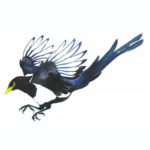
While native flowering plants are the best source of nectar for hummingbirds, supplementing with a well-tended sugar-water feeder can provide additional sustenance during nesting season and migration. Consult our FAQ below to ensure your feeder does no harm—and helps your hummers thrive. (Read more about creating a hummingbird-friendly yard here.)
Q: Are there any downsides to supplying a hummingbird feeder to the birds in my yard?
A: No. Your hummingbird feeder will be a supplemental source of nectar for your local hummingbirds, and can help them through times when there aren’t as many blooming flowers available nearby.
Q: Do I need to buy special food for my hummingbirds?
A: No. The best (and least expensive) solution for your feeder is a 1:4 solution of refined white sugar to tap water. That’s ¼ cup of sugar in 1 cup of water. Bring the solution to a boil, then let it cool before filling the feeder. You can make a larger batch and refrigerate the extra solution, just remember to bring it up to room temperature before you re-fill the feeder.
Q: Should I put red coloring in the nectar solution?
A: No, red coloring is not necessary and the reddening chemicals could prove to be harmful to the birds. Natural nectar itself is a clear solution.
Q: Are hummingbirds attracted to red-colored things?
A: Yes, hummingbirds are attracted to red, as well as other brightly colored objects, because they have learned to associate high-quality nectar with red flowers.
Q: Should I use brown sugar, honey, or molasses instead of white sugar?
A: No, only use refined white sugar. Other sweetening agents have additional ingredients that can prove detrimental to the hummingbirds. Never use artificial sweeteners to make hummingbird nectar.
Q: How often should I empty and clean the feeder?
A: In hot weather, the feeder should be emptied and cleaned twice per week. In cooler weather, once per week is enough. If your hummingbirds empty the feeder with greater frequency, clean it every time it’s empty. Cleaning with hot tap water works fine, or use a weak vinegar solution. Avoid using dish soaps, as this can leave harmful residue in the feeder.
Q: When should I put out my hummingbird feeder?
A: In most areas of North America where hummingbirds leave during the winter, it’s best to put the feeder out about a week before they normally arrive in your yard. This date varies regionally. If you don’t know when your birds usually arrive check with your local Audubon center, chapter, or local bird club.
Q: When should I take down my feeders in the fall?
A: You can leave your feeders out for as long as you have hummingbirds around. You can even continue to provide the feeder after your hummingbirds disappear—late migrants or out-of-range species can show up into early winter. Follow the guidelines for keeping the feeders clean, even if the nectar goes untouched. Always discard any unused nectar in the feeder when you take it down for cleaning.
Q: Won’t it make my hummingbirds stay too late if I continue to leave the feeder out for them?
A: No, hummingbirds are migratory species and are genetically programmed to head south in the fall. It’s not a lack of nectar source or colder weather that makes them leave—they know it’s time based on changes in the length of the day and the angle of the sun.
Q: I live in an area where we have hummingbirds year round. Is it okay for me to feed them year round as well?
A: Absolutely! Just follow the guidelines for keeping your feeders clean.
Q: I put a feeder up, but no hummingbirds have come. How can I get hummingbirds to visit my feeder?
A: Planting red or orange tubular flowers that attract hummingbirds may help them discover your feeder, if you hang it nearby. (Of course, make sure to change the nectar solution and clean the feeder regularly, even if you have not seen any hummingbirds.) You can search for native plants that your hummingbirds naturally visit using our native plants database. Learn more about planting for hummingbirds, and other ways to make your yard hummingbird-friendly, here.
Q: I have a hummingbird in my area past migration time and I’d like to feed it as long as it stays around, what do I need to know?
If you live in an area where the night-time temperatures dip below freezing regularly you will need to make sure your nectar feeder does not freeze. In areas where the nighttime temperatures only dip slightly below freezing your hummingbird nectar may not freeze as the sugar solution has a lower freezing point than plain water. However, it’s better not to have your hummingbirds drink very cold nectar; this can actually cold-stun them. For cold weather feeding, either bring the feeder indoors overnight when it gets cold and put it back outside first thing in the morning (hummingbirds need to feed as early as possible, especially when it’s cold, to keep their energy up) or you can hang an incandescent light bulb near the feeder. These bulbs give off enough heat to keep the feeder warm.
Some areas of the U.S. do see hummingbirds normally over the winter. Several species of hummingbirds regularly overwinter along the Gulf Coast, southern Arizona, and south Florida. Anna’s Hummingbirds are resident from northwestern Baja California along the Pacific coast to British Columbia, Allen’s Hummingbirds are resident in coastal Southern California, and Costa’s Hummingbirds are resident in Baja California, southeast California to western Arizona.
To learn more about the hummingbirds visiting your yard and the winter range of a particular species, download our free Audubon Bird Guide app or refer to Audubon’s online field guide.
